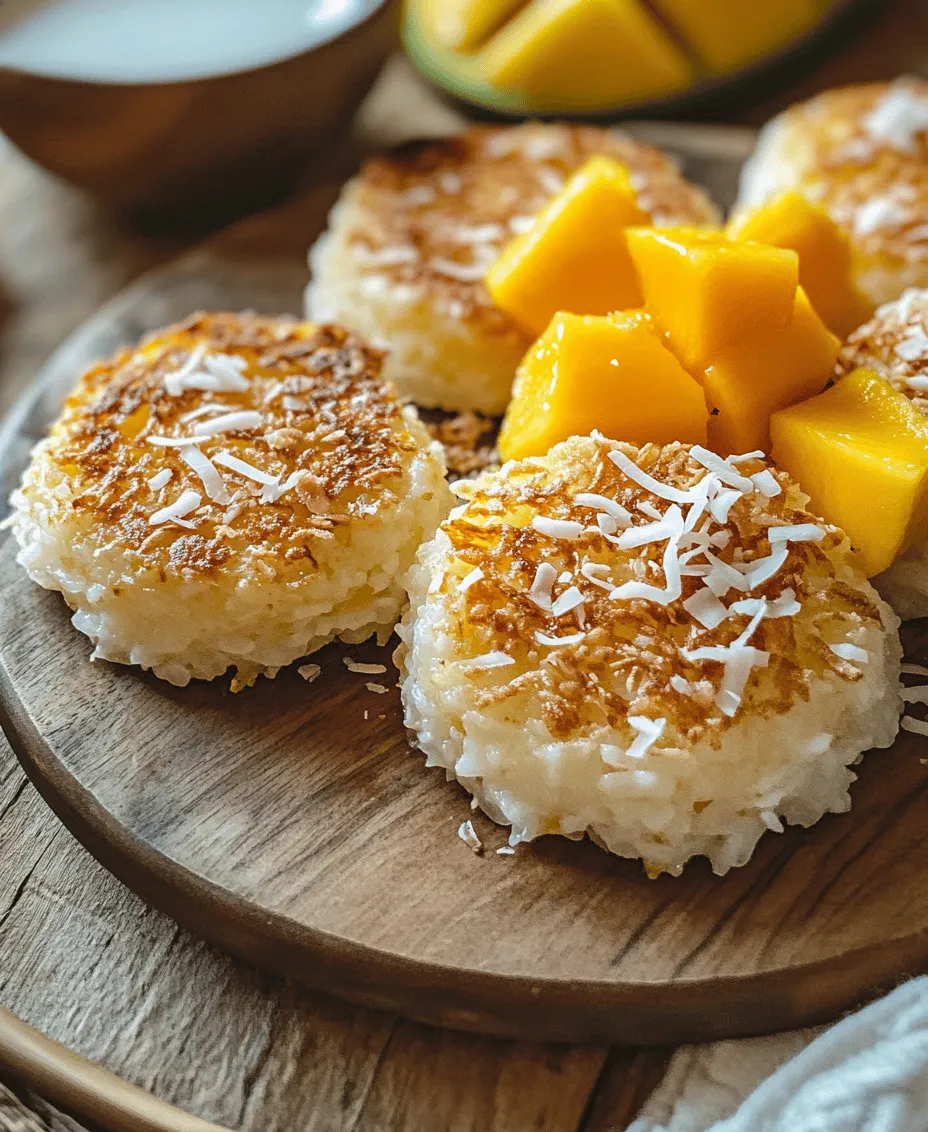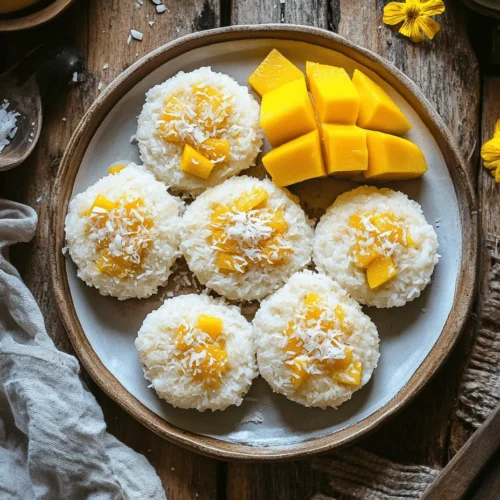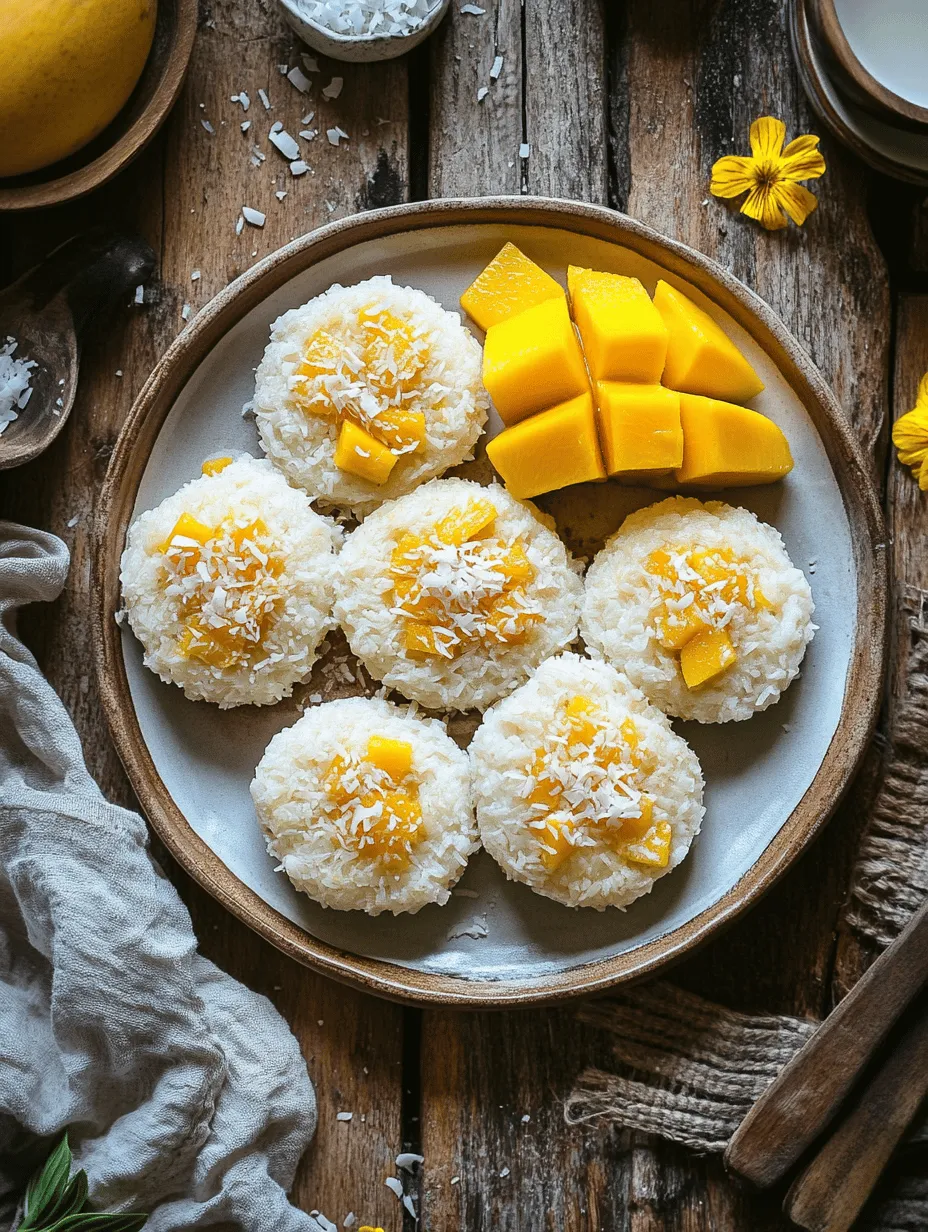Coconut Rice Cakes Delight is a delightful fusion of flavors that transports you to a tropical paradise. Imagine sinking your teeth into soft, flavorful rice cakes that are infused with the sweet, aromatic essence of coconut. This recipe combines the aromatic goodness of jasmine rice with the rich creaminess of coconut milk, resulting in a treat that’s not only delicious but also versatile. Whether you are looking for a snack, dessert, or a unique breakfast option, these rice cakes are customizable and easy to make, ensuring that everyone can enjoy a taste of the tropics.
In this article, we will delve into the process of making these delicious treats, explore the health benefits of the ingredients, and share tips for perfecting your Coconut Rice Cakes Delight. Let’s embark on this culinary journey that promises to evoke the flavors of the islands and bring joy to your kitchen.
Understanding the Key Ingredients
To create the perfect Coconut Rice Cakes Delight, it’s essential to understand the key ingredients that contribute to the dish’s unique flavor and texture. Each component plays a vital role, adding to the overall experience of enjoying this tropical treat.
Exploring Jasmine Rice: The Foundation of Flavor
At the heart of our Coconut Rice Cakes Delight is jasmine rice, a fragrant long-grain rice known for its delicate floral aroma and slightly sticky texture when cooked. This rice variety not only enhances the flavor profile of the cakes but also contributes to their softness.
Characteristics and Benefits of Using Jasmine Rice
Jasmine rice is prized for its nutty flavor and unique texture, making it an ideal base for this recipe. Its ability to absorb liquids well allows it to soak up the richness of coconut milk, creating a moist and flavorful cake. Furthermore, jasmine rice is a gluten-free option, making it suitable for those with dietary restrictions.
Why Rinsing Rice is Essential for Perfect Texture
Before cooking jasmine rice, rinsing it thoroughly is a crucial step. Rinsing helps to remove excess starch, which can cause the rice to become gummy. Instead, you want each grain to remain separate and fluffy. To rinse jasmine rice effectively, place it in a fine mesh strainer and run cold water over it, gently swirling the rice with your fingers until the water runs clear. This simple step is key to achieving the perfect texture in your Coconut Rice Cakes Delight.
The Role of Coconut Milk: Creaminess Meets Nutrition
Coconut milk is another star ingredient in this recipe, bringing a rich, creamy flavor that complements the jasmine rice beautifully. It adds moisture and enhances the overall taste, making each bite of the rice cake a tropical delight.
Nutritional Profile of Coconut Milk
Beyond its delicious flavor, coconut milk is also packed with nutrients. It contains healthy fats, particularly medium-chain triglycerides (MCTs), which are known to provide quick energy and may support weight management. Additionally, coconut milk is a good source of vitamins C and E, as well as several B vitamins, such as folate, which are essential for energy production and overall health.
How Coconut Milk Enhances Flavor and Texture in the Recipe
In Coconut Rice Cakes Delight, coconut milk not only adds creaminess but also lends a subtle sweetness. Its rich texture contrasts beautifully with the fluffy jasmine rice, creating a well-balanced treat. The combination of rice and coconut milk is what makes these cakes so satisfying, and it allows for endless customization options, such as adding spices or fruits.
Sweetening It Up: Choosing the Right Sugar
Sweetness is an essential element in any dessert, and choosing the right sugar can significantly impact the final taste of your Coconut Rice Cakes Delight.
Different Types of Sugar and Their Impact on Flavor
There are various types of sugar you can use in this recipe, each bringing its own character to the dish. Common options include granulated white sugar, brown sugar, and coconut sugar.
– Granulated White Sugar: This is the most straightforward option, providing a clean, sweet flavor without altering the color or texture of the rice cakes.
– Brown Sugar: With its molasses content, brown sugar adds a hint of caramel flavor and a darker color to the cakes, enhancing their tropical essence.
– Coconut Sugar: As a natural sweetener derived from coconut sap, this option is less processed and has a lower glycemic index. It brings a subtle flavor that pairs beautifully with coconut milk and is an excellent choice for those seeking a more natural sweetening alternative.
Adjusting Sweetness to Personal Preference
The level of sweetness in your Coconut Rice Cakes Delight is entirely up to you. Depending on your taste preferences, you can easily adjust the amount of sugar used in the recipe. For a lighter treat, consider reducing the sugar quantity, or if you have a sweet tooth, feel free to add a bit more. The flexibility in sweetness makes this recipe inclusive for all palates.
The Importance of Shredded Coconut
No coconut dish would be complete without shredded coconut, which adds texture and a burst of coconut flavor to your rice cakes.
Types of Shredded Coconut and Their Uses
When selecting shredded coconut, you will find several options, including sweetened, unsweetened, and toasted varieties.
– Sweetened Shredded Coconut: This option is often used in desserts for a sweeter flavor and can blend well into the batter.
– Unsweetened Shredded Coconut: This is the healthier choice, allowing you to control the sweetness of your dish while still enjoying the distinct coconut flavor.
– Toasted Coconut: Toasting shredded coconut enhances its flavor, adding a nutty depth that complements the tropical theme of this recipe.
Choosing the right type of shredded coconut will depend on your personal taste and dietary needs, but unsweetened shredded coconut is generally recommended for a balanced flavor profile.
Nutritional Benefits of Coconut
In addition to its delightful taste, shredded coconut is also a source of healthy fats, fiber, and essential minerals such as manganese, copper, and selenium. These nutrients contribute to various health benefits, including improved digestion, enhanced energy levels, and antioxidant protection. Incorporating shredded coconut into your Coconut Rice Cakes Delight not only elevates the flavor but also adds nutritional value to your treat.
Step-by-Step Guide to Making Coconut Rice Cakes Delight
Now that we’ve explored the key ingredients that make up Coconut Rice Cakes Delight, let’s dive into the detailed, step-by-step guide to creating this tropical masterpiece. Making these rice cakes is a straightforward process, and with a bit of practice, you will perfect your technique.
Rinsing the Rice: Preparing for Perfect Texture
The first step in our recipe is rinsing the jasmine rice, which is essential for achieving that perfect texture we desire in our rice cakes.
Detailed Explanation of the Rinsing Process
To rinse your jasmine rice, measure out the desired amount (typically 1 cup for this recipe) and place it in a fine mesh strainer. Rinse under cold running water, gently moving the rice around with your fingers. Continue rinsing until the water runs clear, indicating that most of the excess starch has been removed. This process usually takes about 2-3 minutes.
Tips for Achieving the Right Consistency in the Rice
After rinsing, allow the rice to drain for a few minutes. This helps to remove any excess water that could affect the cooking process. If you desire an even fluffier texture, you can soak the rinsed rice in water for about 30 minutes before cooking. This will allow the grains to absorb some moisture and swell, further improving the texture of your Coconut Rice Cakes Delight.
Cooking the Rice: Achieving the Perfect Cook
Once your rice is rinsed and drained, it’s time to cook it. Properly cooked rice is crucial for the success of your rice cakes.
Ideal Water-to-Rice Ratio for Jasmine Rice
The ideal water-to-rice ratio for jasmine rice is typically 1.5 cups of water for every 1 cup of rice. However, this may vary slightly depending on the brand of rice and your desired texture. For softer rice cakes, you might opt for a bit more water.
Techniques for Ensuring the Rice is Fluffy and Well-Cooked
To cook the rice, combine the rinsed rice and water in a medium saucepan. Bring the mixture to a boil over medium-high heat. Once boiling, reduce the heat to low, cover the saucepan, and let it simmer for about 15-20 minutes without lifting the lid. After the cooking time is up, remove the saucepan from heat and let it sit, covered, for an additional 10 minutes. This resting period allows the rice to finish cooking and ensures that it remains fluffy.
Creating the Batter: Mixing for Success
With the rice perfectly cooked, we can move on to creating the batter for our Coconut Rice Cakes Delight. This step is where all the flavors come together.
Importance of Evenly Combining Ingredients
In a large mixing bowl, combine the cooked jasmine rice, coconut milk, sugar, and shredded coconut. It’s important to mix these ingredients thoroughly to ensure that the flavors are evenly distributed throughout the batter. Use a spatula or wooden spoon to gently fold the ingredients together.
How to Avoid Overmixing and Maintain Texture
While it’s essential to mix well, be careful not to overmix, as this can result in dense rice cakes. You want to maintain the fluffy texture of the rice while still incorporating all the ingredients. Mixing until just combined is the key to achieving the perfect consistency.
Molding the Cakes: Tips for the Perfect Shape
Now that your batter is ready, it’s time to shape your Coconut Rice Cakes Delight.
Choosing the Right Molds for Baking
You can use various molds to shape your rice cakes, including silicone molds, muffin tins, or even a baking dish for larger cakes. Silicone molds are particularly useful as they make it easy to release the cakes once baked.
Greasing Techniques to Prevent Sticking
Regardless of the mold you choose, greasing is crucial to prevent sticking. Use a light coating of cooking spray or a thin layer of oil on the mold. If you prefer, you can also line the molds with parchment paper for added assurance.
Baking to Perfection: Achieving the Golden Brown Finish
Finally, it’s time to bake your Coconut Rice Cakes Delight to achieve that golden brown finish.
Understanding Baking Times and Temperatures
Preheat your oven to 350°F (175°C). Once preheated, pour the batter into the prepared molds, filling each mold about three-quarters full to allow for rising. Bake for approximately 25-30 minutes, or until the tops are golden brown and a toothpick inserted into the center comes out clean.
Keep an eye on the cakes during the last few minutes of baking to ensure they don’t overcook. The result should be a beautifully golden, aromatic batch of Coconut Rice Cakes Delight ready to enjoy!
By following these detailed steps, you are well on your way to creating a deliciously tropical treat that is sure to impress. Each bite of these coconut-infused rice cakes will take you on a journey to the sun-kissed shores of a tropical paradise. Prepare to delight your taste buds and share the joy with family and friends as you bring this culinary masterpiece to life.

Recognizing Visual Cues for Doneness
When crafting your Coconut Rice Cakes Delight, knowing when your rice cakes are done is crucial for achieving the perfect texture and flavor. Here are some visual cues to guide you:
1. Color: The rice cakes should take on a light golden hue. This indicates that they are cooked and have begun to caramelize slightly, enhancing their flavor.
2. Firmness: Gently press the surface of the rice cakes with a spatula. They should feel firm to the touch but still have a slight give, which suggests they are cooked through but not overdone.
3. Surface Texture: Look for a slightly crispy exterior with a soft interior. The surface should be dry but not burnt, and you may notice a light sheen from the coconut milk.
4. Aroma: As the rice cakes cook, they will release a delightful coconut fragrance. When this aroma fills your kitchen, it’s a good indicator that they are nearing completion.
Cooling and Serving: Enhancing the Eating Experience
Once your rice cakes are perfectly cooked, allow them to cool properly. This step is essential in enhancing their texture and flavor.
The Importance of Cooling the Rice Cakes Properly
Let the coconut rice cakes rest for about 10-15 minutes on a wire rack. This cooling period prevents them from becoming soggy and allows them to firm up, making them easier to slice and serve. If you skip this step, the cakes may lose their shape and become too moist.
Presentation Ideas for Serving
Presentation can elevate the eating experience of your Coconut Rice Cakes Delight. Here are some ideas to make your dish visually appealing:
– Platter Arrangement: Arrange the rice cakes on a vibrant platter, spacing them out to showcase their golden brown color.
– Fresh Greens: Add a bed of fresh mint or banana leaves beneath the rice cakes for a tropical touch.
– Syrup Drizzle: Serve with a drizzle of coconut syrup or a light honey glaze to enhance visual appeal and add a touch of sweetness.
Garnishing Your Coconut Rice Cakes Delight
Garnishing is an opportunity to add freshness and flavor to your Coconut Rice Cakes Delight. Here are some tropical toppings that can elevate your dish:
Tropical Toppings: Adding Freshness and Flavor
Benefits of Using Fresh Mango or Pineapple
Fresh mango and pineapple are excellent choices for garnishing your rice cakes. They bring a burst of color and tropical flavor that complements the coconut beautifully.
– Mango: Rich in vitamins A and C, mango adds a juicy sweetness that balances the rich coconut flavor. Simply cube fresh mango and scatter it over the rice cakes for a bright, refreshing touch.
– Pineapple: Pineapple not only enhances the tropical essence but also provides a tangy contrast to the sweetness of the rice cakes. Grate or finely chop fresh pineapple as a topping, or serve it on the side.
Other Topping Ideas to Enhance the Dish
In addition to mango and pineapple, consider these toppings to diversify your Coconut Rice Cakes Delight:
– Coconut Flakes: Toasted coconut flakes add crunch and intensify the coconut flavor.
– Yogurt: A dollop of coconut yogurt or Greek yogurt adds creaminess and a tangy flavor.
– Chopped Nuts: Sprinkle crushed cashews or pistachios for a nutty texture and added health benefits.
– Honey or Maple Syrup: A light drizzle of honey or maple syrup can enhance sweetness and add depth to the dish.
Serving Suggestions: Versatile Enjoyment
Coconut Rice Cakes Delight is a versatile dish that can be enjoyed in various ways. Here are some serving suggestions:
Ideas for Enjoying Rice Cakes as Snacks or Desserts
– As a Snack: Serve the rice cakes as a mid-afternoon snack with a cup of coconut tea or iced herbal tea. Their sweet flavor and chewy texture make them a satisfying option.
– As a Dessert: Top the rice cakes with a scoop of coconut ice cream or sorbet for a delightful dessert. The combination of warm rice cakes and cold ice cream creates a wonderful contrast.
Pairing Options for a Complete Meal
For a complete meal experience, consider pairing the rice cakes with:
– Fresh Fruit Salad: A refreshing fruit salad with tropical fruits can serve as a bright side dish.
– Savory Dishes: Pair the rice cakes with savory dishes like grilled shrimp or chicken marinated in lime and coconut for a balanced meal.
– Smoothie Bowls: Serve alongside a smoothie bowl for a nutritious breakfast option. The rice cakes’ sweetness will complement the smoothie’s flavors.
Nutritional Benefits of Coconut Rice Cakes Delight
Understanding the nutritional benefits of the ingredients used in Coconut Rice Cakes Delight can further enhance your appreciation of this dish.
Health Benefits of Coconut
Coconut is known for its unique composition and health benefits:
– Overview of Healthy Fats in Coconut: Coconut contains medium-chain triglycerides (MCTs), a type of healthy fat that can provide quick energy and support metabolic health. Unlike long-chain fatty acids, MCTs are metabolized differently, making them a more efficient energy source.
– Potential Health Benefits of Coconut in the Diet: Incorporating coconut into your diet may help improve cholesterol levels, support heart health, and provide anti-inflammatory benefits. The natural antioxidants present in coconut can also contribute to overall wellness.
The Nutritional Value of Jasmine Rice
Jasmine rice, the primary grain in this recipe, also boasts significant nutritional benefits:
– Carbohydrate Content and Energy Benefits: Jasmine rice is a source of complex carbohydrates, providing a steady release of energy. It is an excellent choice for fueling your day or recovering after a workout.
– Vitamins and Minerals Present in Jasmine Rice: Jasmine rice contains essential vitamins and minerals, including B vitamins, iron, and magnesium, which are vital for maintaining good health and energy levels.
Balancing Indulgence with Health
While Coconut Rice Cakes Delight is undeniably delicious, enjoying treats in moderation is key to a balanced diet:
– How to Incorporate Treats Like Rice Cakes into a Balanced Diet: Pair your rice cakes with protein or fiber-rich foods, such as yogurt or nuts, to create a balanced meal. This will help keep you satisfied and energized.
– Portion Control and Mindful Eating Tips: Practice portion control by cutting the rice cakes into small squares or triangles. Pay attention to your hunger cues, savor each bite, and enjoy the flavors. Mindful eating can enhance your experience and promote healthy digestion.
Cultural Significance of Coconut in Cuisine
Coconut is not just a delicious ingredient; it has significant cultural importance in cuisines around the world.
Coconut Around the World: A Culinary Staple
Coconut is a staple ingredient in many tropical regions, contributing to a variety of traditional dishes:
– Exploration of Coconut’s Role in Various Cultures: In Southeast Asia, coconut is used in curries, desserts, and beverages. In Caribbean cuisine, it plays a key role in dishes like coconut rice and curries. Each culture showcases coconut’s versatility and flavor.
– Traditional Dishes Featuring Coconut as a Key Ingredient: Dishes like Thai coconut soup (Tom Kha) and Indian coconut chutney highlight how integral coconut is in various culinary traditions.
Celebrating Tropical Flavors: A Culinary Journey
Coconut Rice Cakes Delight is a celebration of these tropical flavors, paying homage to the diverse culinary traditions that have embraced coconut:
– The Influence of Tropical Ingredients on Global Cuisine: The integration of tropical ingredients like coconut, mango, and pineapple into dishes has enriched global cuisine, bringing a taste of the tropics to tables worldwide.
– How Coconut Rice Cakes Delight Honors These Culinary Traditions: By combining coconut and rice, this recipe honors the cultural significance of these ingredients while creating a unique and delightful dish.
Conclusion
Coconut Rice Cakes Delight offers a unique and flavorful way to indulge in the tropical taste of coconut and rice. With its simple preparation and delightful variations, this recipe can easily become a staple in your kitchen. Whether enjoyed as a sweet snack, a refreshing dessert, or a special breakfast option, these rice cakes are sure to please.
By understanding the ingredients, following the preparation steps, and exploring garnishing ideas, you’ll be able to create a delightful treat that brings a taste of the tropics to your table. Embrace the flavors, enjoy the process, and savor every bite of your Coconut Rice Cakes Delight. With their nutritional benefits and cultural significance, these rice cakes are not just a dish; they are an experience that celebrates the essence of tropical cuisine.



